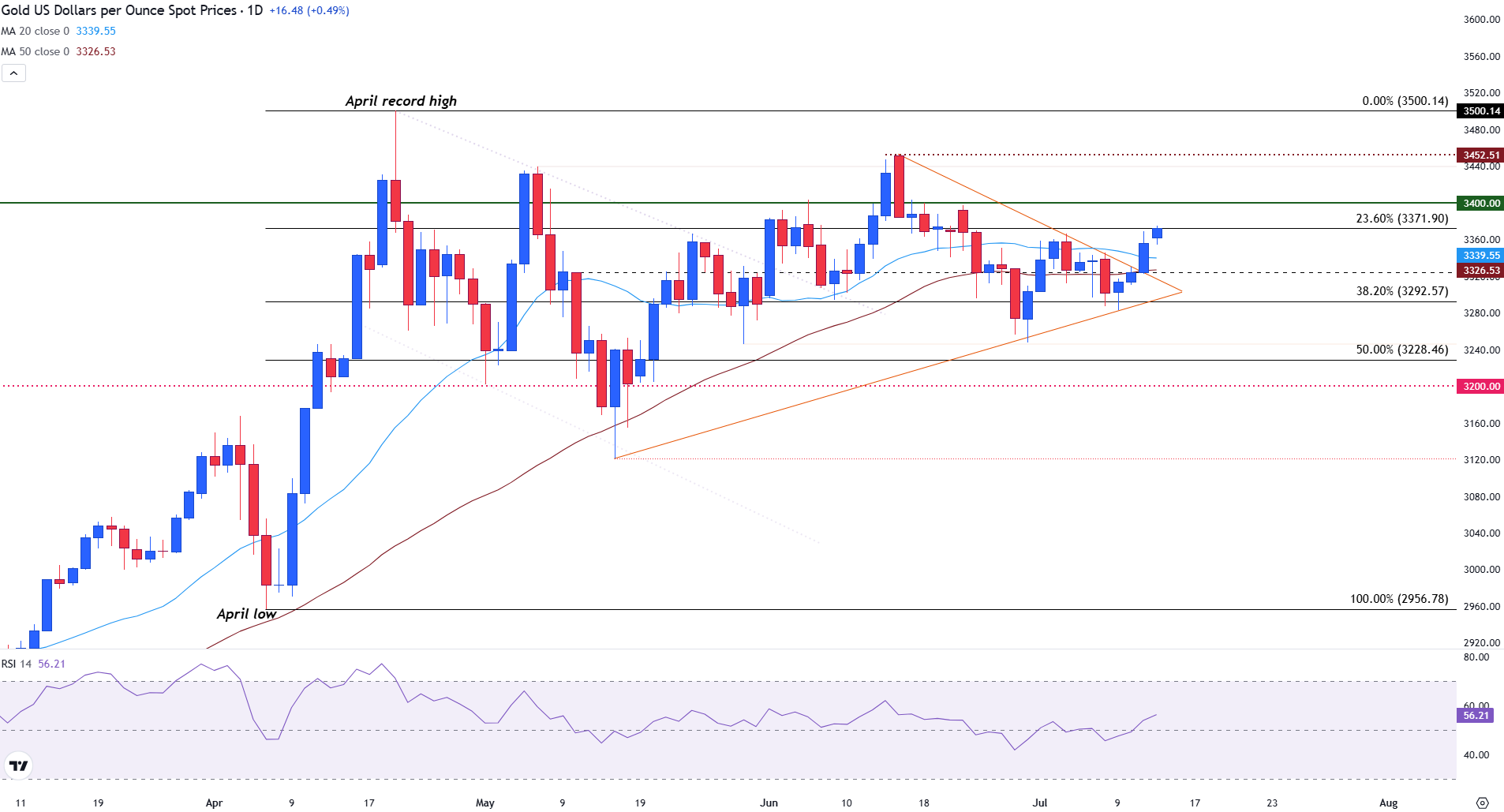Gold jumps in response to Trump’s 30% threat against the EU and Mexico
- Gold extends gains for the fourth consecutive day in response to Trump's tariff threats.
- Safe-haven demand provides a positive tailwind for bullion ahead of Tuesday’s US inflation data.
- XAU/USD bullish breakout brings $3,400 psychological resistance into focus.
Gold (XAU/USD) is climbing on Monday in response to news that the US may impose a 30% tariff on imports from the European Union (EU) and Mexico, effective August 1.
The latest tariff threats on two of America’s largest trading partners have provided a tailwind for XAU/USD. At the time of writing, the Gold price is trading near $3,370 as bulls aim to target psychological resistance at $3,400.
European Commission President Ursula von der Leyen and Mexican President Claudia Sheinbaum received letters from US President Donald Trump on Saturday. His remarks fueled fears of a new wave of blanket tariffs, boosting demand for Gold as a geopolitical hedge.
A busy day of economic data on Tuesday will likely serve as an additional catalyst for Gold. As policymakers assess the potential implications of the country-specific and sector-specific tariffs, US inflation data will be in focus.
Gold daily digest: XAU/USD reacts to Trump tariffs ahead of key economic data releases
- Reuters reports indicate that 23 countries have received letters from the US President to date. Tariffs of 50% on imports from Brazil remain the highest announced so far.
- Formal letters have also stated that these rates “may be modified, upward or downward, depending on our relationship with your country.”
- President Trump’s Truth Social post also warned the EU against retaliating, quoting that "whatever the number you choose to raise them by … will be added onto the 30%."
- The EU Commissioner von der Leyen responded on Sunday. An official statement was published on the European Commission’s press corner, which read, “We remain ready to continue working towards an agreement by August 1. At the same time, we will take all necessary steps to safeguard EU interests, including the adoption of proportionate countermeasures if required.”
- Speaking to NBC News on Thursday, Trump also warned of broader action, stating: “We’re just going to say all of the remaining countries are going to pay, whether it’s 20% or 15%. We’ll work that out now.”
- The US will release the Consumer Price Index (CPI) data for June on Tuesday, providing additional insight into whether tariffs are being reflected in prices. With the Federal Reserve (Fed) closely monitoring tariff risks, this report has a direct impact on monetary policy expectations.
- China’s Q2 Gross Domestic Product (GDP), Industrial Production, and Retail Sales for June are also scheduled for release on Tuesday. Any disappointments reflecting a significant slowdown in economic activity will likely continue to underpin the upside momentum for Gold.
Gold technical analysis: XAU/USD breaks triangle resistance, $3,400 in focus
Gold has broken out of the triangle pattern on the daily timeframe, suggesting a shift in momentum.
The move above the upper trendline and the 20-day Simple Moving Average (SMA) near $3,340 signals growing bullish pressure.
Current price action is testing the 23.6% Fibonacci retracement of the April low-high move, around $3,371, which is closely aligned with the current intraday high.

Gold (XAU/hasUSD) daily chart
If XAU/USD can sustain a close above this zone, the next upside target is the psychological barrier at $3,400.
A clear break of this level could open the door for the June high of $3,452, bringing the April record high near $3,500 back in sight.
On the downside, a move below the 50-day SMA at $3,327 would bring the $3,300 psychological support level back in focus.
With the Relative Strength Index near 56, momentum is trading with a bullish bias. However, there is still room for prices to proceed higher before the market enters overbought territory.
Gold FAQs
Gold has played a key role in human’s history as it has been widely used as a store of value and medium of exchange. Currently, apart from its shine and usage for jewelry, the precious metal is widely seen as a safe-haven asset, meaning that it is considered a good investment during turbulent times. Gold is also widely seen as a hedge against inflation and against depreciating currencies as it doesn’t rely on any specific issuer or government.
Central banks are the biggest Gold holders. In their aim to support their currencies in turbulent times, central banks tend to diversify their reserves and buy Gold to improve the perceived strength of the economy and the currency. High Gold reserves can be a source of trust for a country’s solvency. Central banks added 1,136 tonnes of Gold worth around $70 billion to their reserves in 2022, according to data from the World Gold Council. This is the highest yearly purchase since records began. Central banks from emerging economies such as China, India and Turkey are quickly increasing their Gold reserves.
Gold has an inverse correlation with the US Dollar and US Treasuries, which are both major reserve and safe-haven assets. When the Dollar depreciates, Gold tends to rise, enabling investors and central banks to diversify their assets in turbulent times. Gold is also inversely correlated with risk assets. A rally in the stock market tends to weaken Gold price, while sell-offs in riskier markets tend to favor the precious metal.
The price can move due to a wide range of factors. Geopolitical instability or fears of a deep recession can quickly make Gold price escalate due to its safe-haven status. As a yield-less asset, Gold tends to rise with lower interest rates, while higher cost of money usually weighs down on the yellow metal. Still, most moves depend on how the US Dollar (USD) behaves as the asset is priced in dollars (XAU/USD). A strong Dollar tends to keep the price of Gold controlled, whereas a weaker Dollar is likely to push Gold prices up.

